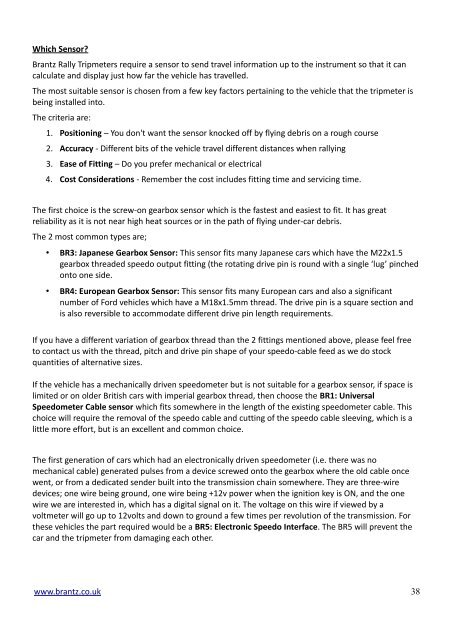Brantz Rally Product Overview - 2019
The Brantz brand of rally equipment offers the complete range of motorsport Tripmeters and Retrotrips for everyone from novice rally enthusiasts all the way to professional team rallying.
The Brantz brand of rally equipment offers the complete range of motorsport Tripmeters and Retrotrips for everyone from novice rally enthusiasts all the way to professional team rallying.
You also want an ePaper? Increase the reach of your titles
YUMPU automatically turns print PDFs into web optimized ePapers that Google loves.
Which Sensor?<br />
<strong>Brantz</strong> <strong>Rally</strong> Tripmeters require a sensor to send travel information up to the instrument so that it can<br />
calculate and display just how far the vehicle has travelled.<br />
The most suitable sensor is chosen from a few key factors pertaining to the vehicle that the tripmeter is<br />
being installed into.<br />
The criteria are:<br />
1. Positioning – You don't want the sensor knocked off by flying debris on a rough course<br />
2. Accuracy - Different bits of the vehicle travel different distances when rallying<br />
3. Ease of Fitting – Do you prefer mechanical or electrical<br />
4. Cost Considerations - Remember the cost includes fitting time and servicing time.<br />
The first choice is the screw-on gearbox sensor which is the fastest and easiest to fit. It has great<br />
reliability as it is not near high heat sources or in the path of flying under-car debris.<br />
The 2 most common types are;<br />
• BR3: Japanese Gearbox Sensor: This sensor fits many Japanese cars which have the M22x1.5<br />
gearbox threaded speedo output fitting (the rotating drive pin is round with a single ‘lug’ pinched<br />
onto one side.<br />
• BR4: European Gearbox Sensor: This sensor fits many European cars and also a significant<br />
number of Ford vehicles which have a M18x1.5mm thread. The drive pin is a square section and<br />
is also reversible to accommodate different drive pin length requirements.<br />
If you have a different variation of gearbox thread than the 2 fittings mentioned above, please feel free<br />
to contact us with the thread, pitch and drive pin shape of your speedo-cable feed as we do stock<br />
quantities of alternative sizes.<br />
If the vehicle has a mechanically driven speedometer but is not suitable for a gearbox sensor, if space is<br />
limited or on older British cars with imperial gearbox thread, then choose the BR1: Universal<br />
Speedometer Cable sensor which fits somewhere in the length of the existing speedometer cable. This<br />
choice will require the removal of the speedo cable and cutting of the speedo cable sleeving, which is a<br />
little more effort, but is an excellent and common choice.<br />
The first generation of cars which had an electronically driven speedometer (i.e. there was no<br />
mechanical cable) generated pulses from a device screwed onto the gearbox where the old cable once<br />
went, or from a dedicated sender built into the transmission chain somewhere. They are three-wire<br />
devices; one wire being ground, one wire being +12v power when the ignition key is ON, and the one<br />
wire we are interested in, which has a digital signal on it. The voltage on this wire if viewed by a<br />
voltmeter will go up to 12volts and down to ground a few times per revolution of the transmission. For<br />
these vehicles the part required would be a BR5: Electronic Speedo Interface. The BR5 will prevent the<br />
car and the tripmeter from damaging each other.<br />
www.brantz.co.uk 38





